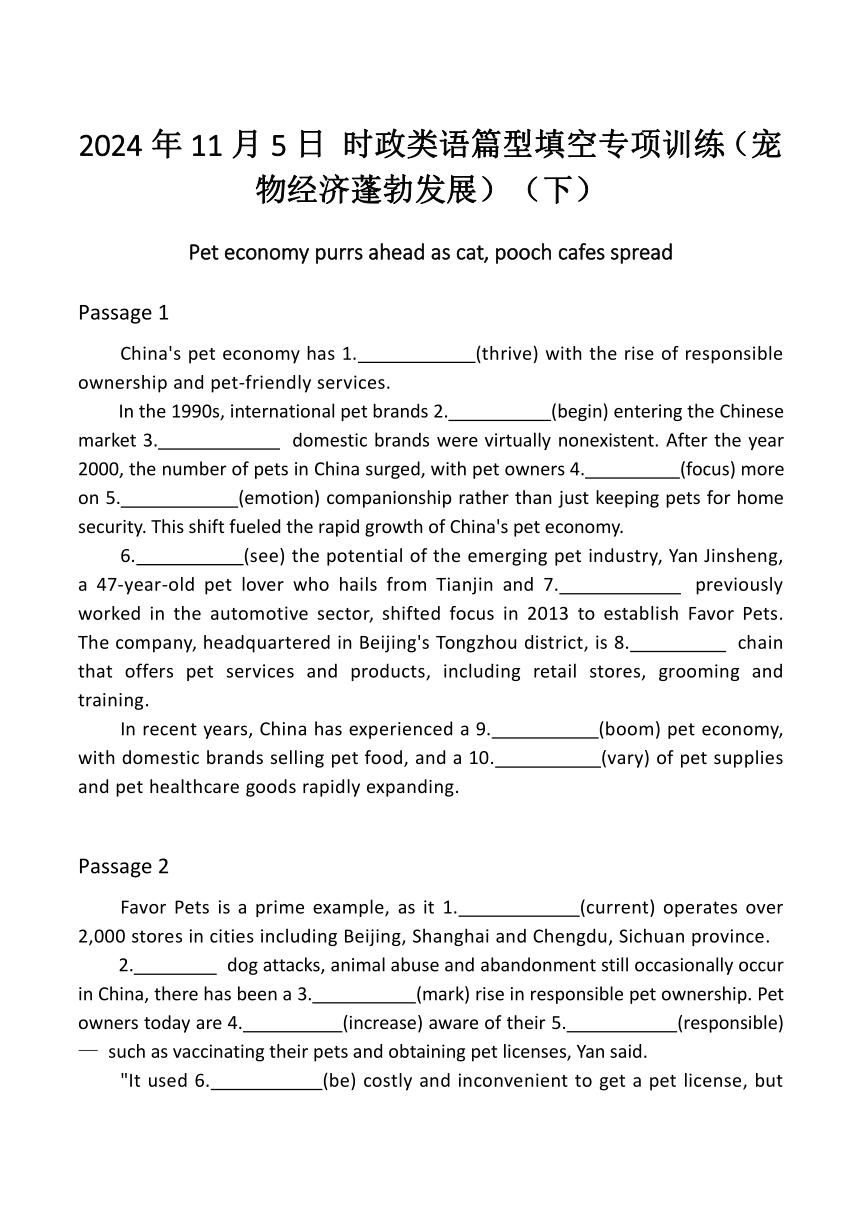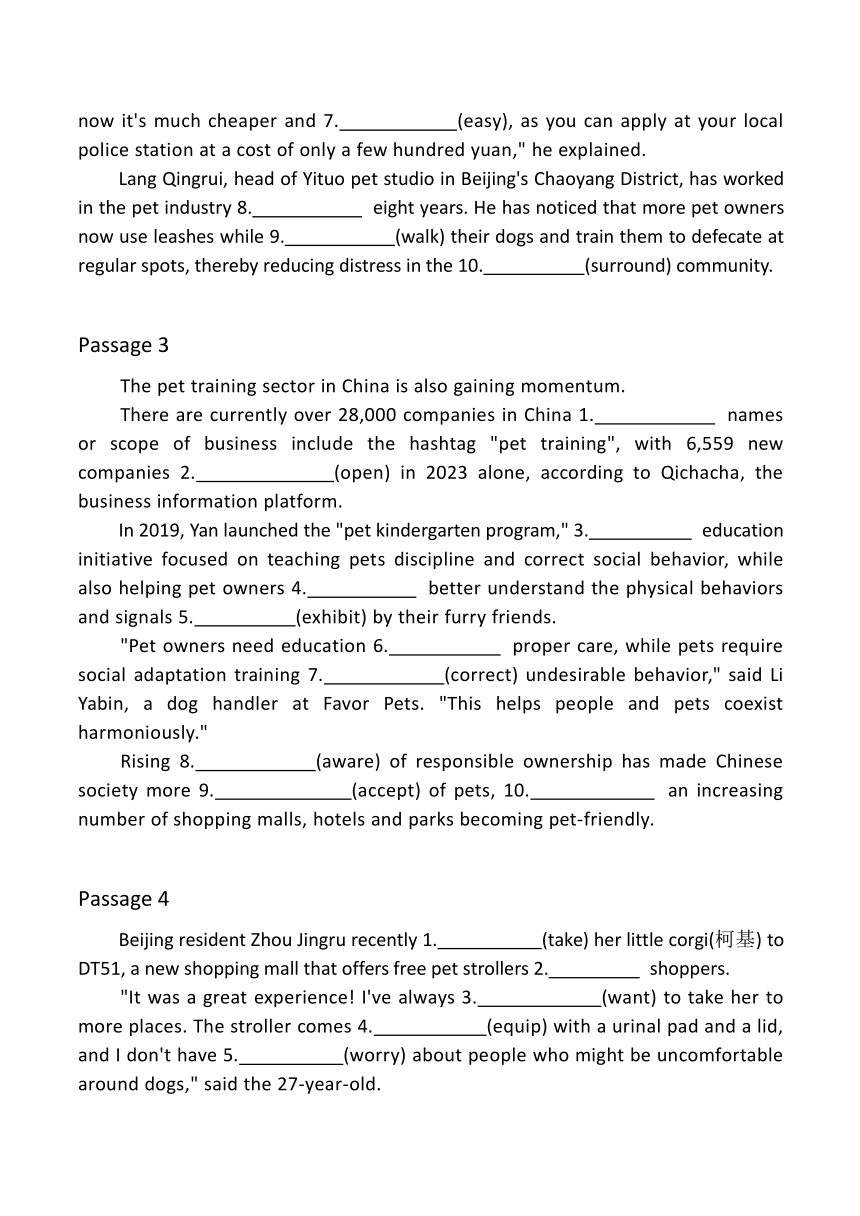2024年11月5日 时政类语篇型填空专项训练(宠物经济蓬勃发展)(下)(4篇,含答案与译文)-2025届高三英语复习专项
文档属性
| 名称 | 2024年11月5日 时政类语篇型填空专项训练(宠物经济蓬勃发展)(下)(4篇,含答案与译文)-2025届高三英语复习专项 |  | |
| 格式 | docx | ||
| 文件大小 | 27.8KB | ||
| 资源类型 | 教案 | ||
| 版本资源 | 人教版(2019) | ||
| 科目 | 英语 | ||
| 更新时间 | 2025-01-21 10:37:11 | ||
图片预览


文档简介
2024年11月5日 时政类语篇型填空专项训练(宠物经济蓬勃发展)(下)
Pet economy purrs ahead as cat, pooch cafes spread
Passage 1
China's pet economy has 1. (thrive) with the rise of responsible ownership and pet-friendly services.
In the 1990s, international pet brands 2. (begin) entering the Chinese market 3. domestic brands were virtually nonexistent. After the year 2000, the number of pets in China surged, with pet owners 4. (focus) more on 5. (emotion) companionship rather than just keeping pets for home security. This shift fueled the rapid growth of China's pet economy.
6. (see) the potential of the emerging pet industry, Yan Jinsheng, a 47-year-old pet lover who hails from Tianjin and 7. previously worked in the automotive sector, shifted focus in 2013 to establish Favor Pets. The company, headquartered in Beijing's Tongzhou district, is 8. chain that offers pet services and products, including retail stores, grooming and training.
In recent years, China has experienced a 9. (boom) pet economy, with domestic brands selling pet food, and a 10. (vary) of pet supplies and pet healthcare goods rapidly expanding.
Passage 2
Favor Pets is a prime example, as it 1. (current) operates over 2,000 stores in cities including Beijing, Shanghai and Chengdu, Sichuan province.
2. dog attacks, animal abuse and abandonment still occasionally occur in China, there has been a 3. (mark) rise in responsible pet ownership. Pet owners today are 4. (increase) aware of their 5. (responsible) — such as vaccinating their pets and obtaining pet licenses, Yan said.
"It used 6. (be) costly and inconvenient to get a pet license, but now it's much cheaper and 7. (easy), as you can apply at your local police station at a cost of only a few hundred yuan," he explained.
Lang Qingrui, head of Yituo pet studio in Beijing's Chaoyang District, has worked in the pet industry 8. eight years. He has noticed that more pet owners now use leashes while 9. (walk) their dogs and train them to defecate at regular spots, thereby reducing distress in the 10. (surround) community.
Passage 3
The pet training sector in China is also gaining momentum.
There are currently over 28,000 companies in China 1. names or scope of business include the hashtag "pet training", with 6,559 new companies 2. (open) in 2023 alone, according to Qichacha, the business information platform.
In 2019, Yan launched the "pet kindergarten program," 3. education initiative focused on teaching pets discipline and correct social behavior, while also helping pet owners 4. better understand the physical behaviors and signals 5. (exhibit) by their furry friends.
"Pet owners need education 6. proper care, while pets require social adaptation training 7. (correct) undesirable behavior," said Li Yabin, a dog handler at Favor Pets. "This helps people and pets coexist harmoniously."
Rising 8. (aware) of responsible ownership has made Chinese society more 9. (accept) of pets, 10. an increasing number of shopping malls, hotels and parks becoming pet-friendly.
Passage 4
Beijing resident Zhou Jingru recently 1. (take) her little corgi(柯基) to DT51, a new shopping mall that offers free pet strollers 2. shoppers.
"It was a great experience! I've always 3. (want) to take her to more places. The stroller comes 4. (equip) with a urinal pad and a lid, and I don't have 5. (worry) about people who might be uncomfortable around dogs," said the 27-year-old.
Wu Yi, an associate professor at the College of Animal Science and Technology at China Agricultural University, pointed 6. that creating a harmonious environment 7. people and pets can coexist requires collective efforts from society. In addition to regulating the responsibilities of pet owners and 8. (strong) pet training, it is 9. (essence) to promote pet friendliness through media and the internet, as well as 10. (advocate) for better laws and regulations to safeguard the safety and interests of the public, she added.
参考答案
参考答案1
1.been thriving 2.began 3.when 4.focusing 5.emotional
6.Seeing 7.had 8.a 9.booming 10.variety
参考译文1
随着负责任的宠物主人和宠物友好型服务的兴起,中国的宠物经济一直在蓬勃发展。
上世纪90年代,在国内宠物品牌几乎不存在的情况下,国际宠物品牌开始进入中国市场。2000年后,中国的宠物数量激增,宠物主人更注重情感上的陪伴,而不仅仅是为了家庭安全而养宠物。这一转变推动了中国宠物经济的快速增长。
看到了新兴宠物行业的潜力,47岁的闫金生(音译),一位来自天津的宠物爱好者,之前曾在汽车行业工作,他在2013年转移了注意力,成立了宠宠公司。该公司总部位于北京通州区,是一家提供宠物服务和产品的连锁店,包括零售店、美容和培训。
近年来,中国宠物经济蓬勃发展,国内品牌销售宠物食品,各种宠物用品和宠物保健品迅速扩大。
参考答案2
1.currently 2.Although 3.marked 4.increasingly 5.responsibilities
6.to be 7.easier 8.for 9.walking 10.surrounding
参考译文2
宠宠就是最好的例子,目前在北京、上海和四川成都等城市经营着2000多家门店。
尽管中国偶尔还会发生狗咬人、虐待动物和遗弃动物的事件,但负责任的宠物主人人数已显著增加。如今,宠物主人越来越意识到自己的责任,比如给宠物接种疫苗和获得宠物许可证,严说。
他解释说:“过去领取宠物证既贵又不方便,但现在便宜多了,也容易多了,你可以在当地派出所申请,只需要几百元。”
郎清瑞是北京朝阳区一坨宠物工作室的负责人,她在宠物行业工作了8年。他注意到,现在越来越多的宠物主人在遛狗时使用皮带,并训练它们在固定的地点排便,从而减少了周围社区的痛苦。
参考答案3
1.whose 2.opening 3.an 4.to 5.exhibited
6.on 7.to correct 8.awareness 9.accepting 10.with
参考译文3
中国的宠物培训行业也在蓬勃发展。
据商业信息平台七查网统计,目前中国有超过2.8万家公司的名称或业务范围包含“宠物培训”标签,仅在2023年就有6559家新公司开业。
2019年,严推出了“宠物幼儿园计划”,这是一项教育计划,专注于教导宠物纪律和正确的社会行为,同时也帮助宠物主人更好地理解他们毛茸茸的朋友的身体行为和信号。
“宠物主人需要接受正确护理的教育,而宠物需要接受社会适应训练,以纠正不良行为,”爱宠训犬师李亚斌(音)说。“这有助于人和宠物和谐共处。”
随着越来越多的购物中心、酒店和公园变得对宠物友好,负责任的饲养意识的增强使中国社会更加接受宠物。
参考答案4
1.took 2.for 3.wanted 4.equipped 5.to worry
6.out 7.where 8.strengthening 9.essential 10.to advocate
参考译文4
北京居民周静茹最近带着她的小柯基去了DT51,这是一家新开的购物中心,为购物者提供免费的宠物推车。
“这是一次很棒的经历!”我一直想带她去更多的地方。这款婴儿车配有便池垫和盖子,我不用担心有人会对狗狗感到不舒服。”
中国农业大学动物科技学院副教授吴毅指出,创造一个人与宠物共存的和谐环境需要全社会的共同努力。
她补充说,除了规范宠物主人的责任和加强宠物培训外,通过媒体和互联网促进宠物友好,以及倡导更好的法律法规来维护公众的安全和利益也很重要。
Pet economy purrs ahead as cat, pooch cafes spread
Passage 1
China's pet economy has 1. (thrive) with the rise of responsible ownership and pet-friendly services.
In the 1990s, international pet brands 2. (begin) entering the Chinese market 3. domestic brands were virtually nonexistent. After the year 2000, the number of pets in China surged, with pet owners 4. (focus) more on 5. (emotion) companionship rather than just keeping pets for home security. This shift fueled the rapid growth of China's pet economy.
6. (see) the potential of the emerging pet industry, Yan Jinsheng, a 47-year-old pet lover who hails from Tianjin and 7. previously worked in the automotive sector, shifted focus in 2013 to establish Favor Pets. The company, headquartered in Beijing's Tongzhou district, is 8. chain that offers pet services and products, including retail stores, grooming and training.
In recent years, China has experienced a 9. (boom) pet economy, with domestic brands selling pet food, and a 10. (vary) of pet supplies and pet healthcare goods rapidly expanding.
Passage 2
Favor Pets is a prime example, as it 1. (current) operates over 2,000 stores in cities including Beijing, Shanghai and Chengdu, Sichuan province.
2. dog attacks, animal abuse and abandonment still occasionally occur in China, there has been a 3. (mark) rise in responsible pet ownership. Pet owners today are 4. (increase) aware of their 5. (responsible) — such as vaccinating their pets and obtaining pet licenses, Yan said.
"It used 6. (be) costly and inconvenient to get a pet license, but now it's much cheaper and 7. (easy), as you can apply at your local police station at a cost of only a few hundred yuan," he explained.
Lang Qingrui, head of Yituo pet studio in Beijing's Chaoyang District, has worked in the pet industry 8. eight years. He has noticed that more pet owners now use leashes while 9. (walk) their dogs and train them to defecate at regular spots, thereby reducing distress in the 10. (surround) community.
Passage 3
The pet training sector in China is also gaining momentum.
There are currently over 28,000 companies in China 1. names or scope of business include the hashtag "pet training", with 6,559 new companies 2. (open) in 2023 alone, according to Qichacha, the business information platform.
In 2019, Yan launched the "pet kindergarten program," 3. education initiative focused on teaching pets discipline and correct social behavior, while also helping pet owners 4. better understand the physical behaviors and signals 5. (exhibit) by their furry friends.
"Pet owners need education 6. proper care, while pets require social adaptation training 7. (correct) undesirable behavior," said Li Yabin, a dog handler at Favor Pets. "This helps people and pets coexist harmoniously."
Rising 8. (aware) of responsible ownership has made Chinese society more 9. (accept) of pets, 10. an increasing number of shopping malls, hotels and parks becoming pet-friendly.
Passage 4
Beijing resident Zhou Jingru recently 1. (take) her little corgi(柯基) to DT51, a new shopping mall that offers free pet strollers 2. shoppers.
"It was a great experience! I've always 3. (want) to take her to more places. The stroller comes 4. (equip) with a urinal pad and a lid, and I don't have 5. (worry) about people who might be uncomfortable around dogs," said the 27-year-old.
Wu Yi, an associate professor at the College of Animal Science and Technology at China Agricultural University, pointed 6. that creating a harmonious environment 7. people and pets can coexist requires collective efforts from society. In addition to regulating the responsibilities of pet owners and 8. (strong) pet training, it is 9. (essence) to promote pet friendliness through media and the internet, as well as 10. (advocate) for better laws and regulations to safeguard the safety and interests of the public, she added.
参考答案
参考答案1
1.been thriving 2.began 3.when 4.focusing 5.emotional
6.Seeing 7.had 8.a 9.booming 10.variety
参考译文1
随着负责任的宠物主人和宠物友好型服务的兴起,中国的宠物经济一直在蓬勃发展。
上世纪90年代,在国内宠物品牌几乎不存在的情况下,国际宠物品牌开始进入中国市场。2000年后,中国的宠物数量激增,宠物主人更注重情感上的陪伴,而不仅仅是为了家庭安全而养宠物。这一转变推动了中国宠物经济的快速增长。
看到了新兴宠物行业的潜力,47岁的闫金生(音译),一位来自天津的宠物爱好者,之前曾在汽车行业工作,他在2013年转移了注意力,成立了宠宠公司。该公司总部位于北京通州区,是一家提供宠物服务和产品的连锁店,包括零售店、美容和培训。
近年来,中国宠物经济蓬勃发展,国内品牌销售宠物食品,各种宠物用品和宠物保健品迅速扩大。
参考答案2
1.currently 2.Although 3.marked 4.increasingly 5.responsibilities
6.to be 7.easier 8.for 9.walking 10.surrounding
参考译文2
宠宠就是最好的例子,目前在北京、上海和四川成都等城市经营着2000多家门店。
尽管中国偶尔还会发生狗咬人、虐待动物和遗弃动物的事件,但负责任的宠物主人人数已显著增加。如今,宠物主人越来越意识到自己的责任,比如给宠物接种疫苗和获得宠物许可证,严说。
他解释说:“过去领取宠物证既贵又不方便,但现在便宜多了,也容易多了,你可以在当地派出所申请,只需要几百元。”
郎清瑞是北京朝阳区一坨宠物工作室的负责人,她在宠物行业工作了8年。他注意到,现在越来越多的宠物主人在遛狗时使用皮带,并训练它们在固定的地点排便,从而减少了周围社区的痛苦。
参考答案3
1.whose 2.opening 3.an 4.to 5.exhibited
6.on 7.to correct 8.awareness 9.accepting 10.with
参考译文3
中国的宠物培训行业也在蓬勃发展。
据商业信息平台七查网统计,目前中国有超过2.8万家公司的名称或业务范围包含“宠物培训”标签,仅在2023年就有6559家新公司开业。
2019年,严推出了“宠物幼儿园计划”,这是一项教育计划,专注于教导宠物纪律和正确的社会行为,同时也帮助宠物主人更好地理解他们毛茸茸的朋友的身体行为和信号。
“宠物主人需要接受正确护理的教育,而宠物需要接受社会适应训练,以纠正不良行为,”爱宠训犬师李亚斌(音)说。“这有助于人和宠物和谐共处。”
随着越来越多的购物中心、酒店和公园变得对宠物友好,负责任的饲养意识的增强使中国社会更加接受宠物。
参考答案4
1.took 2.for 3.wanted 4.equipped 5.to worry
6.out 7.where 8.strengthening 9.essential 10.to advocate
参考译文4
北京居民周静茹最近带着她的小柯基去了DT51,这是一家新开的购物中心,为购物者提供免费的宠物推车。
“这是一次很棒的经历!”我一直想带她去更多的地方。这款婴儿车配有便池垫和盖子,我不用担心有人会对狗狗感到不舒服。”
中国农业大学动物科技学院副教授吴毅指出,创造一个人与宠物共存的和谐环境需要全社会的共同努力。
她补充说,除了规范宠物主人的责任和加强宠物培训外,通过媒体和互联网促进宠物友好,以及倡导更好的法律法规来维护公众的安全和利益也很重要。
